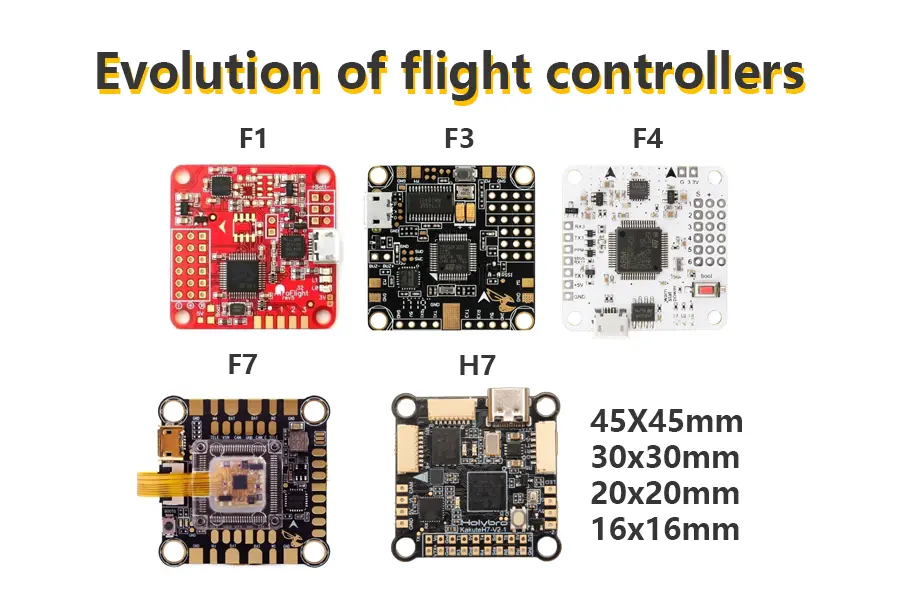Understanding Flight Controller Processors
The evolution of flight controller processors plays a crucial role in FPV drone construction. Let's delve into the breakdown of common processor families used in flight controllers:
F1:
- Earliest generation, now rare in new flight controllers.
- Basic features suitable only for simple drones.
- Pros: Low cost, lightweight.
- Cons: Limited processing power, diminishing firmware support.
F3:
- Popular for budget builds, moderate processing power.
- Balances complex flight modes but not as robust as newer generations.
- Pros: Affordable, decent for basic-to-intermediate users.
- Cons: May lack support for high-performance builds.
F4:
- Current workhorse with high processing power and memory.
- Versatile, handles most modes and sensors smoothly.
- Pros: Good performance-to-cost ratio, widely supported by firmware.
- Cons: Might become outdated for future demanding applications.
G4:
- Similar to F4 but faster clock speeds and improved architecture.
- Ideal for demanding tasks like fast acrobatics.
- Pros: Powerful, future-proof for demanding builds.
- Cons: Often pricier than F4, potentially unnecessary for simpler drones.
F7:
- Alternative high-performance option with a different architecture.
- Powerful for high-end builds with demanding requirements.
- Pros: Excellent performance, good future compatibility.
- Cons: Can be expensive, potentially less widely supported.
H7:
- Top-tier, fastest processors for flight controllers.
- Extreme performance for professional-level drones and racing.
- Pros: Unmatched responsiveness, future-proof.
- Cons: High cost, overkill for most hobbyists.
Choosing the Right Processor
Consider factors like budget, skill level, and the drone’s purpose:
- F4 serves well for most hobbyists.
- G4 and F7 offer slightly better performance.
- Reserve H7 for true high-end applications.
Deciphering FPV Drone Flight Controller Sizes
The size of a flight controller significantly impacts the drone build. Here's an overview of common sizes:
30.5 x 30.5mm:
- Standard for larger drones (above 5 inches).
- Ample space for essential components and additional hardware.
25.5 x 25.5mm:
- Popular for mid-sized drones (3-5 inches).
- Ideal balance between size and functionality.
20 x 20mm:
- Perfect for micro drones below 3 inches.
- Extremely compact, lightweight, but limited space for features.
16 x 16mm:
- Designed for whoop drones or indoor builds.
- Incredibly lightweight but with very limited functionality.
TinyWhoop: Sizing up for Micro Quad Flight Controllers
TinyWhoop sizes primarily fit the 16 x 16mm format, enabling incredibly lightweight and agile drones for indoor spaces:
- Micro Whoops: Smallest and lightest, perfect for indoor freestyle.
- 1S Whoops: Powered by single-cell LiPo batteries for longer flight times.
- Brushless Whoops: May use 20 x 20mm boards for better component placement.
Choosing Flight Controllers for Different FPV Drone Sizes
Selecting the right flight controller involves considerations for size, processor, features, and budget:
Mini Flight Controllers (20x20):
- Focus on compatibility and weight constraints.
- MEPS AIO and Flight controller Flight Controller F4-11 MINI offer a good balance.
5-10 Inch FPV Drones:
- For larger drones, prioritize compatibility and community recommendations.
- F4 boards with integrated ESCs and barometers offer a good balance of performance and features.



